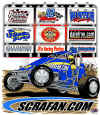


|
Traditional Sprint Car FanSite |
See You At The Races!!! |
| The
Cornbelt Classic by Norm Bogan |
|
|
|
In this day of Interstate highways and well-stocked spacious haulers, it is somewhat difficult to envision traveling from race to race in 1962. To enable the younger folks to comprehend this exercise and to jog the memories of more mature readers, I have created the fictional “CORNBELT CLASSIC”. This was a four race series ran at some dusty fairgrounds ovals in mid-America. Ellsworth, Kansas is located at the junction of state routes 156 and 111, not far from the geographical center of the U.S.A. Here on the plains, you can look for miles in any direction and see corn and wheat. The skyscraper in this part of the country is the local grain elevator. Typical of most small towns, there was a market, post office, gas station and feed store. There were also several small industries, dealing in agricultural related products and services. Corky Long and Buzz Wentworth had grown up in Ellsworth and were boyhood chums. Corky worked at a local store that sold and serviced agricultural pumps as a rebuilder and drove a modified on weekends. Buzz had opened a small shop to do auto and farm implement repairs and served as Corky’s mechanic. Corky had saved up money during his senior year in high school to buy a racecar. He bought a 1941 Ford Coupe for fifty dollars and Buzz converted it into a jalopy racer. After two seasons with some success, they sold the jalopy and purchased a worn out modified. It was an old narrowed chassis stock car, with a 327 c.i. Chevy engine. After rebuilding the car, they had another good season, winning several features at their local track. They were on the road to fame and fortune.Recently these two had received a flyer announcing the first annual Cornbelt Classic. It would be a long June weekend, traveling to four tracks located in Kansas,
Nebraska and Iowa, where they would challenge the other local heroes. After the races, they pointed the pickup north on
U.S. 81 and drove to a roadside rest near Concordia, where they bedded down for
the night. In the morning, they munched on some sandwiches, they had packed at home and pulled the left bank
head to find a leaking gasket. Driving into town, they stopped at the Western Auto and got a new gasket and headed west
on state route 28 to U.S. 36 and then north on U.S. 281 to Red Cloud, Nebraska
and the Webster County Fairgrounds. As they signed in, they were greeted by one of the competitors, Howard Condon, who invited them to share his shade tree in the pit
area. It was a pleasant afternoon and the racer ran fine, staying cool with the newly installed head gasket. On the last lap, a brush with another car sent the car into the wall and
broke the front spring eye. They
still picked up $30 for the night. After
the race, Howard invited them to follow him back to the family farm about
seventy miles away and spend the night on the way to the Saturday show. The track at Harlan was bigger than what they usually ran, so a gear change was in order. Because of the earlier rain, the track was tacky, but got slicker as the feature started. It was the right combination for Corky, as his somewhat worn tires seem to adhere to the surface and he claimed the $250 first place money. Leaving Harlan after the race, the pair traveled south on U.S. 59 for about fifty miles and found a five dollar motel near the intersection of U.S. 6, where they got a restful sleep and a good breakfast at the adjacent Mary Jane’s Café. > This Sunday drive would take them south through St. Joseph, Missouri and across the river to Atchison, Kansas.
It was a warm, muggy afternoon at the Atchison County Fairgrounds. There was a good sized crowd in the stands and this looked like an
outstanding finale for the Cornbelt Classic. On Tuesday evening, just as Corky was about to go down to Buzz’ shop to work on the car, the phone rang. It was George Selkirk, who owned the IMCA sprint car driven by Billy Burgess. Selkirk told Corky that Burgess had just signed with a USAC team to run midgets, sprints and champ cars, so he needed a driver to run his car at Des Moines on Sunday. Selkirk had seen Corky run at Harlan and Atchison and felt he had the talent to run on rough and tumble IMCA circuit. This story could have taken place just about anywhere in the country. No matter what kind of cars they raced or where the tracks were, there were guys just like Corky and Buzz who were the roots of what is today, a megabucks operation. We owe a lot to their perseverance for the racing programs, which we enjoy today. |
